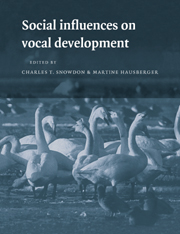Book contents
- Frontmatter
- Contents
- List of contributor
- 1 Introduction
- 2 Social interaction and sensitive phases for song learning: A critical review
- 3 Social interaction and vocal development in birds
- 4 Building a social agenda for the study of bird song
- 5 Field observations, experimental design, and the time and place of learning bird songs
- 6 Vocal learning in wild and domesticated zebra finches: Signature cues for kin recognition or epiphenomena?
- 7 What birds with complex social relationships can tell us about vocal learning: Vocal sharing in avian groups
- 8 Social influences on song acquisition and sharing in the European starling (Sturnus vulgaris)
- 9 Social influences on the acquisition of human-based codes in parrots and nonhuman primates
- 10 Vocal learning in captive bottlenose dolphins: A comparison with humans and nonhuman animals
- 11 Vocal learning in cetaceans
- 12 Social influences on vocal development in New World primates
- 13 Some general features of vocal development in nonhuman primates
- 14 Social influences on vocal learning in human and nonhuman primates
- 15 The resilience of language in humans
- 16 Reciprocal interactions and the development of communication and language between parents and children
- 17 Crafting activities: Building social organization through language in girls' and boys' groups
- Index
12 - Social influences on vocal development in New World primates
Published online by Cambridge University Press: 04 August 2010
- Frontmatter
- Contents
- List of contributor
- 1 Introduction
- 2 Social interaction and sensitive phases for song learning: A critical review
- 3 Social interaction and vocal development in birds
- 4 Building a social agenda for the study of bird song
- 5 Field observations, experimental design, and the time and place of learning bird songs
- 6 Vocal learning in wild and domesticated zebra finches: Signature cues for kin recognition or epiphenomena?
- 7 What birds with complex social relationships can tell us about vocal learning: Vocal sharing in avian groups
- 8 Social influences on song acquisition and sharing in the European starling (Sturnus vulgaris)
- 9 Social influences on the acquisition of human-based codes in parrots and nonhuman primates
- 10 Vocal learning in captive bottlenose dolphins: A comparison with humans and nonhuman animals
- 11 Vocal learning in cetaceans
- 12 Social influences on vocal development in New World primates
- 13 Some general features of vocal development in nonhuman primates
- 14 Social influences on vocal learning in human and nonhuman primates
- 15 The resilience of language in humans
- 16 Reciprocal interactions and the development of communication and language between parents and children
- 17 Crafting activities: Building social organization through language in girls' and boys' groups
- Index
Summary
INTRODUCTION
The study of vocal development in nonhuman animals has focused primarily on vocal production. However, vocal development involves not only production, but development of appropriate usage and appropriate responses to the calls of others. The relative neglect of usage and responses has led to a distorted view of vocal development as emphasized by Seyfarth & Cheney (Chapter 13) for monkeys and West et al. (Chapter 4) for birds. The argument is often made that nonhuman mammals differ fundamentally in vocal development from both birds and human beings but, as we have argued previously (Snowdon & Elowson 1992) and Seyfarth & Cheney (Chapter 13) argue, primates are similar to humans and birds if all three components of vocal development – production, usage and response – are evaluated.
In this chapter we argue that when functionally similar vocalizations are chosen from species that have similar social organization, then similar developmental processes will be found regardless of the taxon studied. We examine the idea that nonhuman primate vocal structures are fixed and review evidence that vocal plasticity may be quite common. We then provide three examples of phenomena from our research with marmosets and tamarins that illustrate how plasticity in pygmy marmoset trill vocalizations can be influenced by changes in social companions, how infant babbling in pygmy marmosets is a social interaction, and how the structure and usage of food-associated calls is acquired by cotton-top tamarins, and how social environments can inhibit the expression of these calls.
- Type
- Chapter
- Information
- Social Influences on Vocal Development , pp. 234 - 248Publisher: Cambridge University PressPrint publication year: 1997
- 28
- Cited by

